16 Simple Exercises for Weight Loss From a Former Olympian
Weight loss is primarily accomplished through controlling the diet, finding balance with the consumption of nutrient-dense foods, and avoiding overconsumption based on what your body needs for the day. Excess caloric intake is stored as fat as a survival mechanism of the body, and over time, overconsumption leads to weight gain, with every 3,500 calories of energy consumed equating to 1lb of body weight. So, exercise number 1 is to exercise control over what you consume each day, limit refined sugars and empty non-nutritional foods, and meet your personal caloric intake. The great news is that physical exercise is a fantastic mechanism for burning additional calories. Here are 20 exercise tips to help you tone up on the weight loss journey.
Muscle Building Moves

Building muscle is the secret weapon for weight loss because lean body mass burns additional calories so this is a sustainable approach to long term success. Exercise that targets large muscle groups gets you more bang for your effort.
Muscle Building Moves: Squats
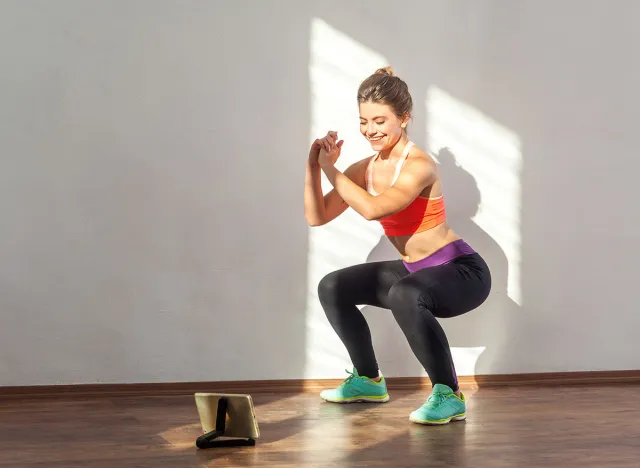
What it does: Squats engage multiple muscle groups, including the quadriceps, hamstrings, glutes, and lower back, promoting overall lower body strength and development.
Why it works: Squats are a compound movement, meaning they recruit several large muscle groups simultaneously, leading to increased calorie burn and muscle growth.
How many to do: Aim for 3 sets of 10-12 reps to start, adjusting weight and reps as needed to challenge your muscles effectively.
Muscle Building Moves: Lunges
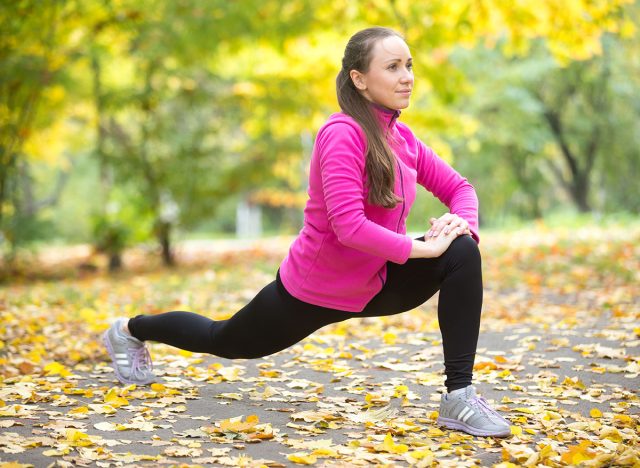
What it does: Lunges primarily target the quadriceps, hamstrings, and glutes while also engaging the core for stability.
Why it works: Like squats, lunges are a compound exercise that recruits multiple muscle groups, contributing to calorie burn and muscle development.
How many to do: Start with 3 sets of 10-12 reps per leg, gradually increasing intensity by adding weights or variations like walking lunges.
Muscle Building Moves: Push-Ups
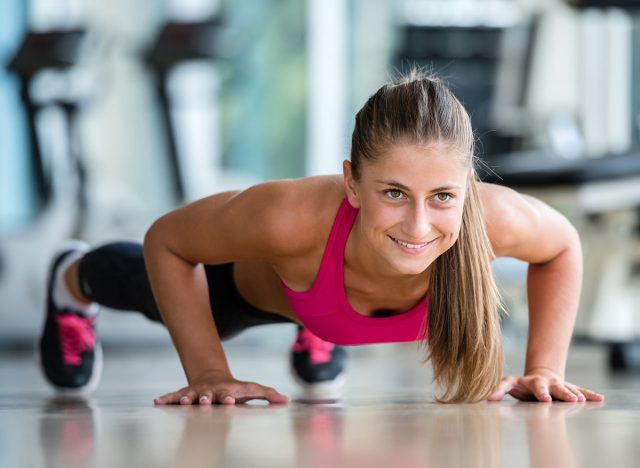
What it does: Push-ups strengthen the chest, shoulders, triceps, and core muscles.
Why it works: Push-ups are a fundamental bodyweight exercise that effectively engages multiple upper body muscle groups, contributing to increased muscle mass and calorie expenditure.
How many to do: Aim for three sets of 8-12 reps, focusing on maintaining proper form throughout each repetition.
RELATED: 15 Food Swaps That Will Save You Hundreds of Calories a Day and Help You Lose Weight
Muscle Building Moves: Lat Pull Downs
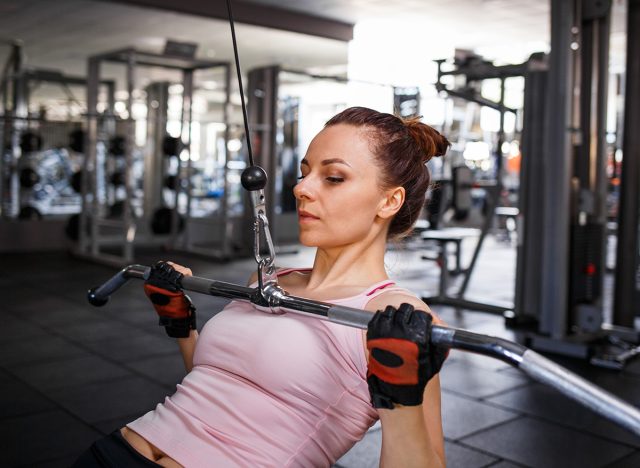
What it does: Lat pull downs primarily target the latissimus dorsi muscles of the back, along with the biceps and shoulders.
Why it works: This exercise helps develop upper body strength and muscle definition, contributing to overall calorie burn and metabolic rate.
How many to do: Perform 3 sets of 8-12 reps, adjusting the weight to ensure proper form and challenge for each set.
Muscle Building Moves: Chest Press
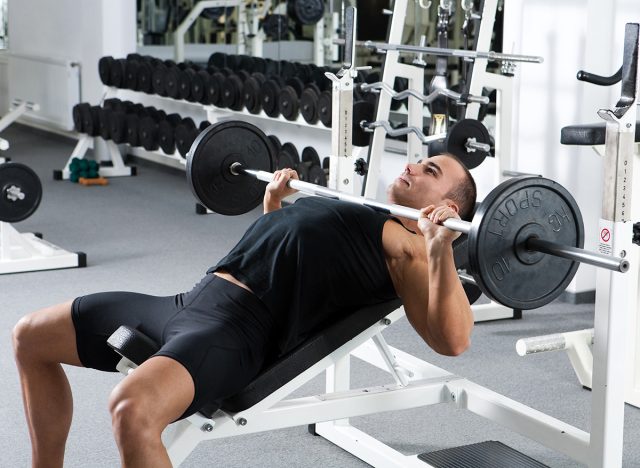
What it does: Chest press exercises target the pectoral muscles, shoulders, and triceps.
Why it works: By focusing on the chest and upper body, chest presses help build muscle mass and strength, increasing overall calorie expenditure during and after workouts.
How many to do: Start with 3 sets of 8-12 reps, gradually increasing weight as your strength improves.
Cardio with Muscle Focus
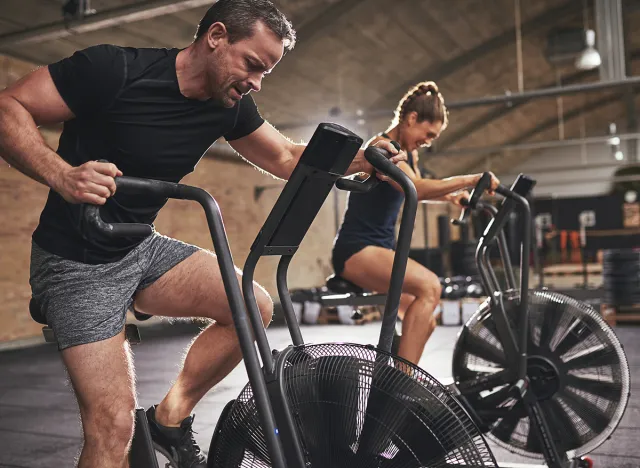
Doing steady state cardio with a muscle build focus can be achieved with resistance. Here are some of my favorites.
Cardio with Muscle Focus: Treadmill Steep Incline
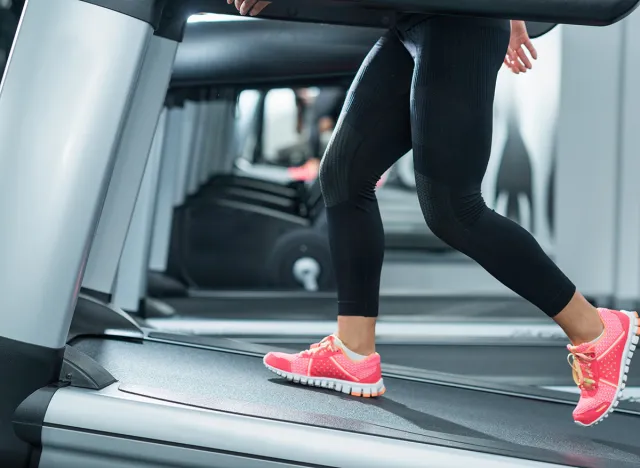
What it does: Walking or running on a treadmill with a steep incline engages the lower body muscles, particularly the glutes, hamstrings, and calves, while also increasing cardiovascular endurance.
Why it works: The steep incline adds resistance, intensifies the workout and increases calorie burn compared to flat-surface cardio.
How many to do: Aim for 20-30 minutes of incline treadmill walking or running as part of your cardio routine, adjusting speed and incline to maintain the challenge.
Cardio with Muscle Focus: Stair Stepper
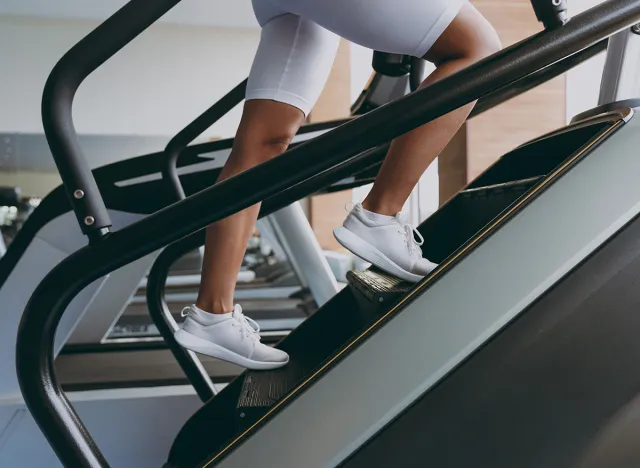
What it does: The stair stepper simulates climbing stairs, targeting the lower body muscles, including the quadriceps, hamstrings, glutes, and calves, while also providing a cardiovascular workout.
Why it works: Stepping against resistance challenges the leg muscles and elevates heart rate, leading to calorie burn and improved endurance.
How many to do: Incorporate 20-30 minutes of stair stepper workouts into your routine, gradually increasing duration or intensity as fitness improves.
RELATED: 9 People Share Their Proven Strategies for Losing Over 40 Pounds
Cardio with Muscle Focus: Walking the Real Stairs

What it does: Walking or running up stairs engages the lower body muscles similar to the stair stepper, providing a cardiovascular and strength-building workout.
Why it works: Stair climbing targets multiple muscle groups while also elevating heart rate, making it an effective calorie-burning exercise.
How many to do: Incorporate stair climbing into your routine by using stairs instead of elevators whenever possible or dedicating 20-30 minutes to stair climbing workouts.
Cardio with Muscle Focus: Hike Uphill

What it does: Uphill hiking engages the leg muscles, core, and cardiovascular system, providing a full-body workout while also improving balance and coordination.
Why it works: Hiking uphill against gravity increases resistance, challenges muscles, and burns more calories than flat terrain.
How many to do: Aim for 60-90 minutes of uphill hiking per session, gradually increasing duration or difficulty as fitness improves.
Cardio with Muscle Focus: Running Fast
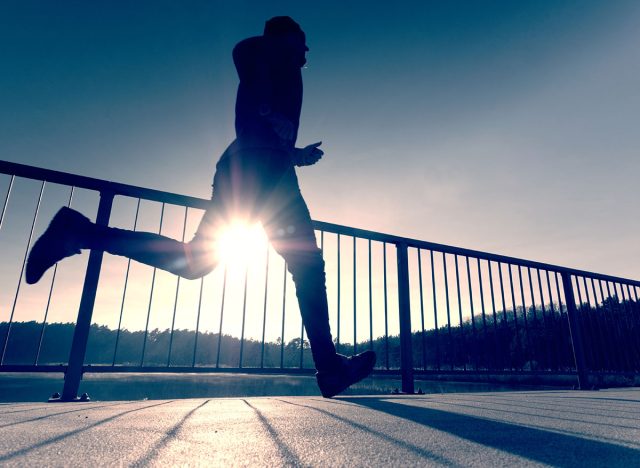
What it does: Sprinting involves explosive, high-intensity bursts of running, primarily targeting the lower body muscles, including the quadriceps, hamstrings, glutes, and calves, while also engaging the core and upper body for stability.
Why it works: Sprinting elevates heart rate and metabolism, leading to significant calorie burn during and after exercise, while also promoting muscle development and power.
How many to do: Incorporate sprint intervals into your cardio routine, such as alternating between 30 seconds of sprinting and 60 seconds of walking or jogging, for a total of 10-15 minutes per session. Adjust intensity and duration based on fitness level and goals.
Slow and Steady, Low Impact Workouts

You can get a nice slow calorie burn with some classic favorites, because of the low impact steady nature you need to put in time on the clock. 45 minutes or more is a good starting point for slow and steady moves.
RELATED: 15 Reasons Why You May Not Losing Weight While on Ozempic
Slow and Steady: Swimming
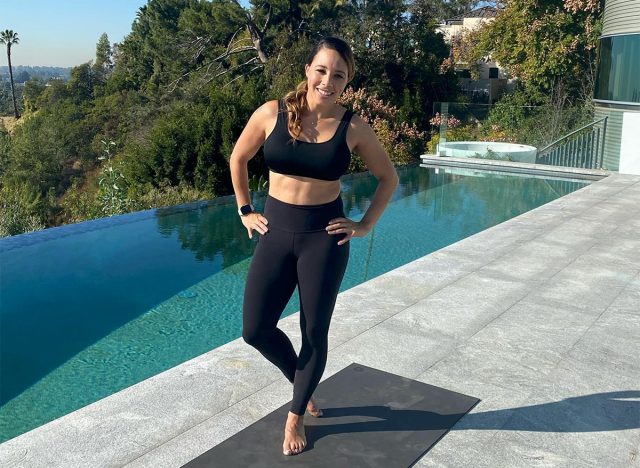
What it does: Swimming engages various muscle groups throughout the body, providing a low-impact cardiovascular workout while also building strength and endurance.
Why it works: The resistance of water challenges muscles while the rhythmic movements increase heart rate, promoting calorie burn and overall fitness.
How many to do: Aim for 45-60 minutes of swimming per session, adjusting intensity and strokes to maintain challenge and enjoyment.
Slow and Steady: Long Walk/Run

What it does: Walking or running for an extended period targets the lower body muscles and cardiovascular system, providing a steady calorie burn and endurance challenge.
Why it works: Long-duration aerobic exercise promotes fat oxidation and improves cardiovascular health, contributing to weight loss and overall fitness.
How many to do: Dedicate at least 45 minutes to an hour for long walks or runs, gradually increasing duration or distance as fitness improves.
Slow and Steady: Step Class
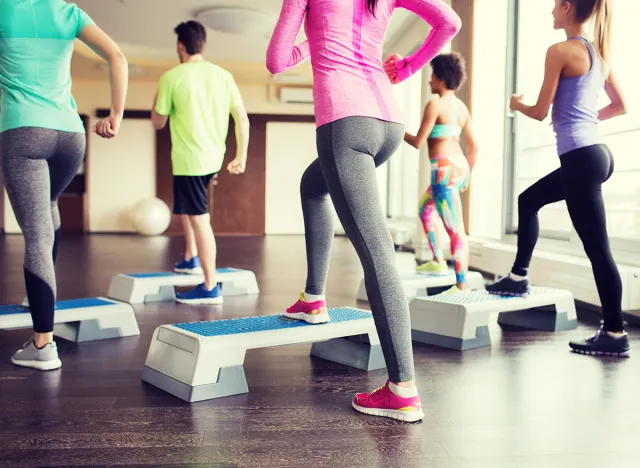
What it does: Step classes involve choreographed routines using a raised platform, targeting the lower body muscles and cardiovascular system while improving coordination and agility.
Why it works: The repetitive stepping motions elevate heart rate and engage leg muscles, providing a fun and effective calorie-burning workout.
How many to do: Participate in 45-60 minute step classes, following the instructor's cues for intensity and duration.
Slow and Steady: Spin Class
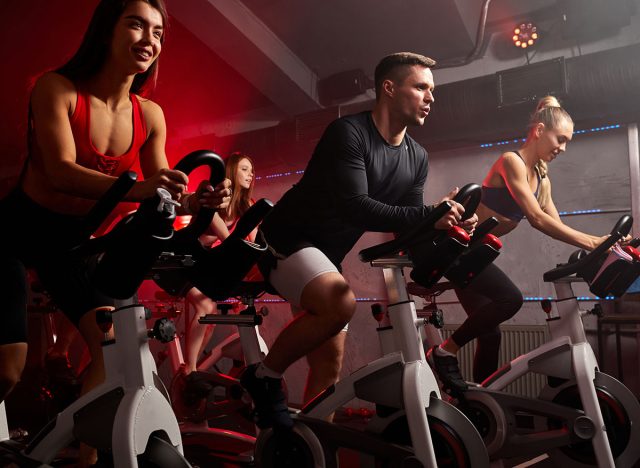
What it does: Spin classes involve stationary cycling with varying resistance levels and speeds, targeting the leg muscles and cardiovascular system while providing a high-intensity, low-impact workout.
Why it works: Cycling against resistance challenges leg muscles and elevates heart rate, promoting calorie burn and endurance while minimizing the impact on joints.
How many to do: Attend 45-60 minute spin classes, adjusting resistance and speed to match fitness level and goals.
RELATED: 12-3-30 Walking Method: 20 Proven Tips to Lose Weight Faster
Rowing
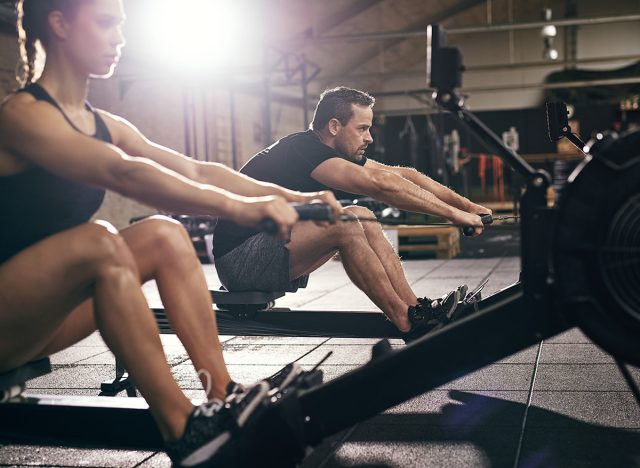
What it does: Rowing engages the legs, core, back, and arms, providing a full-body cardiovascular and strength-building workout.
Why it works: Rowing against resistance challenges muscles and elevates heart rate, leading to calorie burn and improved cardiovascular health.
How many to do: Aim for 20-30 minutes of rowing per session, adjusting resistance and stroke rate to maintain challenge and intensity.
High Intensity Intervals

There are a few ways to get the calorie burn. High intense moves burn primarily readily available carbs/sugars and glycogen stores in the body, however the post exercise oxygen debt recovery burns some good old fat stores.
High Intensity Intervals: Tabata

What it does: Tabata involves mixing rest intervals with periods of high-intensity work, promoting calorie burn and cardiovascular fitness in a short amount of time.
Why it works: The intense bursts of exercise elevate heart rate and metabolism, leading to significant calorie burn during and after the workout, while the brief rest periods allow for recovery.
How many to do: Perform Tabata intervals consisting of 20 seconds of high-intensity exercise followed by 10 seconds of rest, repeating for a total of 4 minutes per exercise. Choose exercises like box jumps, jump rope, banded squats, reverse lunge skips, and jumping jacks for maximum effectiveness.
RELATED: 20 Incredible Ozempic Success Stories of All Time
Don't Forget About Diet

The best way to lose weight is to be consistent with your exercise routine and focusing your nutrition especially on what you need to eat before – during and after your workout to best support the body's energy needs and recovery. Walking away from unhealthy snacks is a great place to start.
💪🔥Body Booster:To achieve sustainable weight loss, focus on building muscle through exercises that target large muscle groups. Increasing your lean body mass will help you burn more calories in the long run.
Samantha Clayton is a certified fitness trainer, personal and group trainer, AFAA, ISSA, and NASM.





